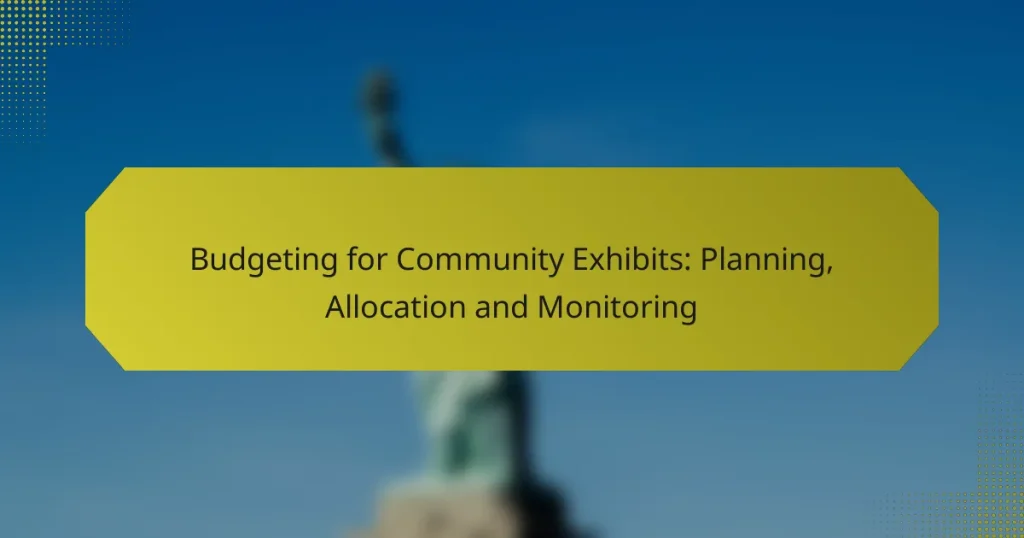Budgeting and funding strategies are crucial for the success of cultural exhibits, ensuring that resources are effectively allocated to maximize impact while maintaining financial sustainability. By employing various budgeting methods such as zero-based or performance-based budgeting, organizations can tailor their financial planning to meet specific needs. Additionally, securing grants and utilizing diverse fundraising methods like crowdfunding and corporate sponsorships can significantly enhance the quality and reach of cultural programming.
Managing Financial Risks in Exhibit Projects: Assessment, Mitigation and Contingency
Sponsorship Options for Cultural Exhibits: Types, Benefits and Negotiation
Budgeting for Community Exhibits: Planning, Allocation and Monitoring
Grant Opportunities for Cultural Exhibits: Sources, Applications and Benefits
Funding Models for Exhibits: Nonprofit, For-Profit and Hybrid
Cost-Effective Exhibit Marketing: Strategies, Channels and Metrics
What are effective budgeting strategies for cultural exhibits?
Effective budgeting strategies for cultural exhibits involve planning and allocating resources to ensure financial sustainability while maximizing impact. Key approaches include zero-based, incremental, activity-based, and performance-based budgeting, each offering unique advantages and considerations.
Zero-based budgeting
Zero-based budgeting (ZBB) requires that every expense must be justified for each new period, starting from a “zero base.” This method encourages a thorough review of all costs and can lead to more efficient allocation of resources, as it eliminates unnecessary expenditures.
When implementing ZBB, consider involving all stakeholders to identify essential activities and prioritize funding accordingly. This approach can be particularly useful in cultural exhibits where funding may fluctuate, ensuring that only the most impactful projects receive support.
Incremental budgeting
Incremental budgeting involves adjusting the previous year’s budget to account for changes in funding or expenses. This method is straightforward and less time-consuming, making it suitable for organizations with stable funding sources.
However, it may perpetuate inefficiencies if past expenditures are not critically evaluated. To avoid this, regularly assess the relevance of each line item and consider whether adjustments reflect current priorities and goals for the cultural exhibit.
Activity-based budgeting
Activity-based budgeting (ABB) focuses on the costs associated with specific activities or projects within the cultural exhibit. This approach allows for a more detailed understanding of how funds are utilized and can help identify areas for cost savings.
By linking budget allocations directly to activities, organizations can better assess the return on investment for each aspect of the exhibit. This method is particularly effective when planning for diverse programming or outreach initiatives, ensuring that resources align with strategic objectives.
Performance-based budgeting
Performance-based budgeting ties funding to the achievement of specific outcomes or objectives. This strategy emphasizes accountability and encourages organizations to focus on results rather than merely inputs.
To implement this approach, establish clear performance metrics and regularly evaluate progress against these goals. This method can enhance transparency and foster a culture of continuous improvement within cultural exhibits, ultimately leading to better audience engagement and satisfaction.
How can grants support cultural exhibits?
Grants can provide essential funding for cultural exhibits, enabling organizations to cover costs such as materials, staffing, and marketing. They often come from government entities or private foundations and can significantly enhance the scope and quality of cultural programming.
National Endowment for the Arts grants
The National Endowment for the Arts (NEA) offers grants specifically aimed at supporting cultural exhibits across the United States. These grants typically fund projects that promote artistic excellence and public engagement, with awards ranging from a few thousand to several hundred thousand dollars.
To apply for NEA grants, organizations must demonstrate how their project aligns with the NEA’s goals and provide a detailed budget. It’s crucial to adhere to deadlines and guidelines, as competition can be intense.
State arts council funding
State arts councils provide funding to support local cultural exhibits, often tailored to the specific needs of the community. Each state has its own application process and funding priorities, which can include grants for operational support, project funding, and educational initiatives.
Organizations should research their state’s arts council to understand eligibility requirements and funding cycles. Many councils also offer workshops or resources to help applicants prepare strong proposals.
Private foundation grants
Private foundations often fund cultural exhibits through grants that focus on specific themes, such as education, community engagement, or diversity. These grants can vary widely in size and scope, with some foundations providing substantial support for innovative projects.
When seeking private foundation grants, it’s important to align your project with the foundation’s mission and funding priorities. Building relationships with foundation staff and demonstrating the potential impact of your exhibit can enhance your chances of securing funding.
What are the best fundraising methods for cultural exhibits?
The best fundraising methods for cultural exhibits include crowdfunding campaigns, corporate sponsorships, and membership programs. Each method offers unique advantages and challenges, making it essential to choose the right mix based on your exhibit’s goals and audience.
Crowdfunding campaigns
Crowdfunding campaigns allow cultural exhibits to raise funds directly from the public, typically through online platforms. These campaigns can be effective for generating interest and support, especially if the exhibit has a compelling story or unique features.
To launch a successful crowdfunding campaign, set a clear funding goal and timeline. Utilize social media to promote the campaign and engage potential backers. Offering rewards, such as exclusive merchandise or behind-the-scenes access, can incentivize contributions.
Corporate sponsorships
Corporate sponsorships involve partnering with businesses that provide financial support in exchange for brand visibility and marketing opportunities. This method can significantly enhance funding while also promoting the sponsor’s brand to a targeted audience.
When seeking corporate sponsors, focus on companies whose values align with the exhibit’s mission. Prepare a sponsorship proposal that outlines the benefits for the sponsor, including promotional opportunities and potential audience reach. Be mindful of maintaining the exhibit’s integrity and mission when selecting sponsors.
Membership programs
Membership programs encourage individuals to support cultural exhibits through annual fees in exchange for benefits such as free admission, exclusive events, and newsletters. This approach fosters a loyal community and provides a steady revenue stream.
To create an appealing membership program, consider offering tiered levels with varying benefits. Regularly communicate with members to keep them engaged and informed about upcoming events and initiatives. Ensure that the value of membership is clear to attract and retain participants.
How can ticket sales enhance funding for cultural exhibits?
Ticket sales can significantly boost funding for cultural exhibits by providing a direct revenue stream. By implementing various sales strategies, organizations can maximize attendance and increase overall income, which can be reinvested into future exhibits and community programs.
Dynamic pricing models
Dynamic pricing models adjust ticket prices based on demand, time of purchase, and other factors. This strategy can optimize revenue by charging higher prices during peak times while offering lower rates during off-peak periods. For example, a cultural exhibit might charge $15 during weekends and $10 on weekdays, attracting more visitors when prices are lower.
Consider using software tools that analyze attendance patterns to set optimal pricing. However, be cautious of alienating price-sensitive customers; ensure that pricing remains accessible for diverse audiences.
Group ticket sales
Group ticket sales offer discounts for bulk purchases, encouraging schools, organizations, and families to attend together. This approach not only increases ticket sales but also enhances the exhibit’s community engagement. For instance, a group of 10 might receive a 20% discount, making the total cost more appealing.
Promote group sales through partnerships with local schools and community organizations. Ensure that the process for booking group tickets is straightforward to avoid potential barriers to purchase.
Early bird discounts
Early bird discounts incentivize visitors to purchase tickets in advance, providing upfront cash flow for cultural exhibits. Offering a reduced price for tickets bought weeks before the event can help gauge interest and secure funding early on. A common strategy is to offer a 15% discount for tickets purchased at least a month in advance.
Clearly communicate the deadline for early bird pricing to create urgency. However, balance this with a standard pricing strategy to avoid losing potential attendees who may prefer last-minute purchases.
What role do partnerships play in funding cultural exhibits?
Partnerships are crucial for funding cultural exhibits as they provide access to additional resources, expertise, and networks. Collaborating with various stakeholders can enhance financial support and broaden audience reach, making exhibits more sustainable and impactful.
Collaborations with local businesses
Local businesses can play a significant role in funding cultural exhibits through sponsorships or in-kind contributions. For instance, a local restaurant might provide catering for an opening event in exchange for promotional opportunities. This type of collaboration not only reduces costs but also fosters community engagement.
When approaching businesses, consider creating tiered sponsorship levels with corresponding benefits, such as logo placement or exclusive previews. This strategy can incentivize more businesses to participate and support your exhibit financially.
Academic partnerships
Partnering with academic institutions can enhance the credibility and educational value of cultural exhibits. Universities often have resources, such as research funding or student volunteers, that can be leveraged to support exhibit development. Additionally, faculty expertise can enrich the content and programming of the exhibit.
To establish these partnerships, reach out to relevant departments that align with your exhibit’s theme. Propose collaborative projects that benefit both the institution and the exhibit, such as joint workshops or research initiatives.
Community organization alliances
Alliances with community organizations can significantly boost funding and outreach for cultural exhibits. These organizations often have established networks and can help mobilize volunteers, promote events, and attract diverse audiences. They may also have access to grants specifically aimed at community engagement.
Identify local organizations that share a mission or demographic focus with your exhibit. Collaborate on programs or events that highlight mutual goals, which can lead to shared funding opportunities and increased visibility within the community.





